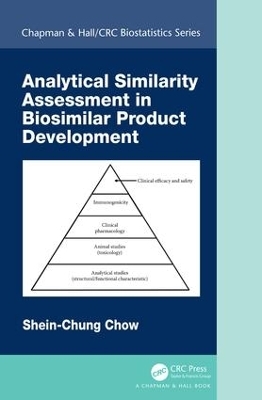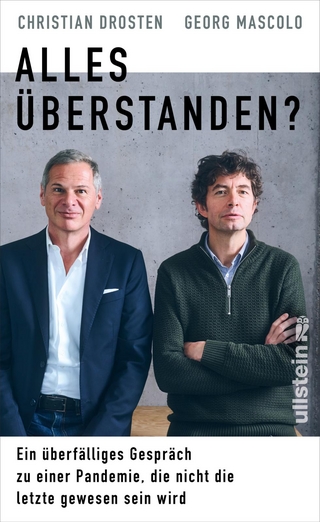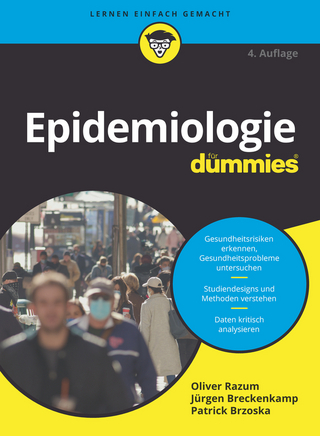
Analytical Similarity Assessment in Biosimilar Product Development
CRC Press (Verlag)
978-1-138-30733-9 (ISBN)
This book focuses on analytical similarity assessment in biosimilar product development following the FDA’s recommended stepwise approach for obtaining totality-of-the-evidence for approval of biosimilar products. It covers concepts such as the tiered approach for assessment of similarity of critical quality attributes in the manufacturing process of biosimilar products, models/methods like the statistical model for classification of critical quality attributes, equivalence tests for critical quality attributes in Tier 1 and the corresponding sample size requirements, current issues, and recent developments in analytical similarity assessment.
Author Shein-Chung Chow, Ph.D, is currently an Associate Director at Office of Biostatistics, Center for Drug Evaluation and Research, United States Food and Drug Administration (FDA). Prior to joining FDA, Dr. Chow was a Professor at Duke University School of Medicine, Durham, NC. He was also a special government employee (SGE) appointed by the FDA as an Advisory Committee member and statistical advisor to the FDA. Prior to that, Dr. Chow also held various positions in the pharmaceutical industry such as Vice President at Millennium, Cambridge, MA, Executive Director at Covance, Princeton, NJ, and Director and Department Head at Bristol-Myers Squibb, Plainsboro, NJ. Dr. Chow is the Editor-in-Chief of the Journal of Biopharmaceutical Statistics and the Editor-in-Chief of the Biostatistics Book Series at Chapman and Hall/CRC Press, Taylor & Francis Group. He was elected Fellow of the American Statistical Association and an elected member of the ISI (International Statistical Institute). Dr. Chow is the author or co-author of over 300 methodology papers and 29 books including Designs and Analysis of Bioavailability and Bioequivalence Studies, Sample Size Calculations in Clinical Research, Adaptive Design Methods in Clinical Trials, Translational Medicine, Design and Analysis of Clinical Trials, and Quantitative Methods for Traditional Chinese Medicine Development.
1.1 Background 1.2 Past Experience for In Vitro Bioequivalence Testing 1.2.1 Study Design and Data Collection 1.2.2 Bioequivalence Limit 1.2.3 Statistical Methods 1.2.4 Sample Size Requirement 1.3 Analytical Similarity Assessment 1.3.1 Tier 1 Equivalence Test 1.3.2 Tier 2 Quality Range Approach 1.3.3 Tier 3 Raw Data and Graphical Comparison 1.4 Scientific Factors and Practical Issues 1.4.1 Fundamental Similarity Assumption 1.4.2 Primary Assumptions for Tiered Approach 1.4.3 Fixed Approach for Margin Selection 1.4.4 Inconsistent Test Results between Tiered Approaches 1.4.5 Sample Size Requirement 1.4.6 Relationship between Similarity Limit and Variability
| Erscheinungsdatum | 23.09.2018 |
|---|---|
| Zusatzinfo | 70 Tables, black and white |
| Verlagsort | London |
| Sprache | englisch |
| Maße | 156 x 234 mm |
| Gewicht | 444 g |
| Themenwelt | Mathematik / Informatik ► Mathematik |
| Medizin / Pharmazie ► Medizinische Fachgebiete ► Pharmakologie / Pharmakotherapie | |
| Medizin / Pharmazie ► Pharmazie | |
| Studium ► Querschnittsbereiche ► Epidemiologie / Med. Biometrie | |
| Naturwissenschaften ► Biologie | |
| Technik | |
| ISBN-10 | 1-138-30733-5 / 1138307335 |
| ISBN-13 | 978-1-138-30733-9 / 9781138307339 |
| Zustand | Neuware |
| Informationen gemäß Produktsicherheitsverordnung (GPSR) | |
| Haben Sie eine Frage zum Produkt? |
aus dem Bereich


